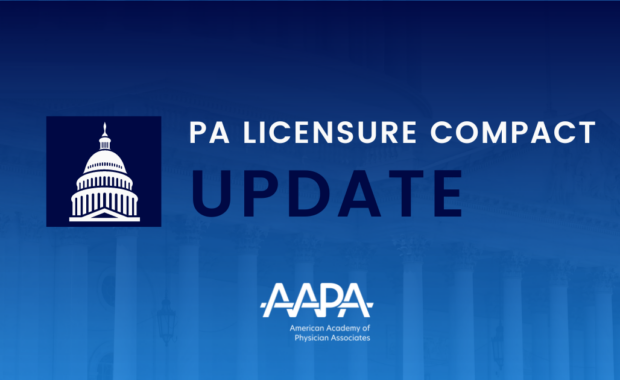In-Flight Medical Emergency: PA Saves Physician’s Life Over the Pacific
“Even in the most stressful and unpredictable situations, she’s sharp, compassionate, and composed—exactly who you’d want in a crisis.”
April 30, 2025
By Dave Andrews

After a 10-day family vacation in Hawaii, Emily Haley, PA-C, boarded a late-night flight bound for home, expecting nothing more than a quiet ride. But high above the Pacific Ocean, she found herself back in the role she knows best—emergency medicine provider.
About halfway through the flight from Honolulu to Los Angeles, a flight attendant’s urgent call rang out: “Is there a doctor on board?” When no one responded, the request shifted to, “Is there any medical provider who can help?”
Haley pressed her call button and within seconds, a frantic flight attendant was leading her toward the front of the plane.
“Based on how panicked the flight attendant was, it was clear that this was serious,” said Haley, an emergency medicine PA at MedStar Franklin Square Medical Center in Baltimore.
She was brought to the first-class lavatory where a woman sat doubled over, clutching her chest, drenched in sweat. The woman was Dr. Jaquelyn Lacera, a family medicine physician who was traveling home with her husband from their honeymoon.
Dr. Lacera described her symptoms to Haley and said the pain was so intense, she felt as though she was having a heart attack. Even in her distress, Dr. Lacera told Haley multiple times that she was sorry for ruining her trip.
“But I’ll never forget Emily’s response: She said, ‘Oh, don’t worry about it. I’ve been off [work] for the past 10 days and I’ve been itching to get back at it.’
“That actually made me laugh,” said Dr. Lacera, who has worked alongside countless PAs throughout her nearly 30-year career.
Troubleshooting Without the Right Supplies
Haley quickly assessed Dr. Lacera using the limited tools in airplane’s emergency medical kit. Based on vital signs and symptoms, she determined the physician was suffering from an irregular heartbeat.
She inserted an IV using the only available fluid—just 500cc—and began trying to stabilize Dr. Lacera’s heart rhythm. In addition to having very little fluid, the emergency medical kit did not have essential medications to help address the doctor’s low blood pressure. And FAA rules barred the crew from asking passengers to share personal medications.
Haley had Dr. Lacera lie on the floor as she attempted to increase her thoracic pressure. However, not only did the doctor’s symptoms persist, but her condition began to worsen with increasing chest pain and shortness of breath.
“The pain was a 10 out of 10—and I consider myself to have a high threshold for pain,” said Dr. Lacera, who remained cognizant throughout the ordeal despite her weakened condition.
The two providers did their best to remain optimistic as they brainstormed options. But they both recognized the onboard resources were lacking, even beyond the dearth of medication.

“It was either the equipment wasn’t available, or it wasn’t working,” Haley said. “The glucose monitor didn’t work. I couldn’t hear anything with that disposable stethoscope. And even the blood pressure cuff—it was one of those portable electronic ones that are notoriously inaccurate.”
Haley tried palpating the doctor’s pulses, but her low blood pressure made it difficult to get an accurate assessment. Attempts to monitor Dr. Lacera’s rhythm with her Apple Watch also failed to provide reliable data.
“Atrial fibrillation—that’s the one rhythm [my Apple Watch] is supposed to register—but it didn’t,” Dr. Lacera said. “All of the equipment that Emily had to work with was just ridiculous. I was alarmed by how low-quality everything was.”
Shock Advised
An hour into the crisis, a flight attendant remembered there was, in fact, an automated external defibrillator (AED) onboard and brought it to Haley. Once connected, the machine indicated “shock advised.”
Haley cautiously rebooted the AED to ensure the reading was not a mistake. She allowed it to cycle three more times, and ultimately, its recommendation was the same: “shock advised.”
“In these situations in the ED, we’d do a controlled cardioversion with sedation,” Haley explained. “But this was completely different—no anesthesia, on an airplane floor, with a conscious patient—definitely not your typical course of action.”
Knowing they still had more than an hour before landing and seeing no other alternatives, Haley turned to Dr. Lacera and said, “I think I have to shock you.”
“Let’s do it,” Dr. Lacera responded with little hesitation.
Haley instructed everyone to step back and when she deployed the shock, the doctor let out a loud scream. “I’m sure I woke up the whole plane with that one,” she said.
After the jolt, Dr. Lacera’s chest pain immediately began to melt away. Haley eventually helped her back to her seat just as the plane was preparing to land.
Calm Amidst Chaos
“Emily was an angel—a total godsend, in my book,” said Dr. Lacera. “Not all medical professionals are trained to manage emergencies as well as she is, simply because they don’t typically deal with these types of things every day.”

Dr. Sarah Rimm, Haley’s supervising physician at MedStar Franklin Square, agrees that providers across various specialties will have different comfort levels for high-stress situations.
“Helping patients in critical condition and in their most vulnerable state is where emergency medicine providers excel,” Dr. Rimm said. “We adapt quickly because we see the unexpected every single day.”
Having worked alongside Haley for the past five years and observing how she adeptly goes about her work, Dr. Rimm was not at all surprised after hearing about how she handled the in-flight emergency.
“Emily always has such a positive attitude and can remain calm amidst all the chaos,” Dr. Rimm said. “Even in the most stressful and unpredictable situations, she’s sharp, compassionate, and composed—exactly who you’d want in a crisis.”
Pushing for Change
Dr. Lacera says she strongly believes the experience happened for a reason. She and Haley remain in touch as they try to bring more attention to the need for enhanced on-board medical supplies.
“The airlines think they’re ready—but they’re not,” Dr. Lacera said. “The lack of adequate equipment is just shocking to me. People don’t realize how ill-prepared these planes and crews are.”
Together, they’ve reached out to lawmakers and airline officials, advocating for policy changes, improved airline reporting, and heightened standards for medical kits. While progress has been slow, they are committed to their goal of raising awareness.
“We’re determined to make something good come out of this,” Haley said. “I think we’re gradually making progress, and I’m hopeful that the momentum will build toward positive change.”
You May Also Like
Physician Associate Jenny Burke Responds to a Cardiac Arrest on the Ski Slope and in the Operating Room
Nonprofit Director and Future PA Delivers Critical Care During Natural Disaster
During Her First Marathon, PA Melissa Volpe Stopped to Save the Life of a Fellow Runner
Thank you for reading AAPA’s News Central
You have 2 articles left this month. Create a free account to read more stories, or become a member for more access to exclusive benefits! Already have an account? Log in.


